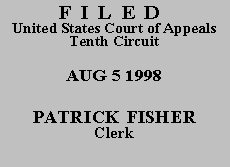

| UNITED STATES OF AMERICA,
Plaintiff-Appellee, v. JOHNNY E. GLOVER, Defendant-Appellant. |
|
Defendant appeals from the district court's denial of his motion to vacate, set aside, or correct his sentence, filed pursuant to 28 U.S.C. § 2255. The district court denied the motion as time-barred because defendant did not file it within the grace period set forth in United States v. Simmonds, 111 F.3d 737, 746 (10th Cir. 1997).(1)
In response to the district court's denial of his motion as time-barred, defendant argues on appeal that he did not file his § 2255 motion in a timely manner because the government created an impediment to his filing the motion in violation of the Constitution. We have held that the one-year limitation period added to the post-conviction statutes by AEDPA is, indeed, a statute of limitations and, as such, is not jurisdictional. Cf. Miller v. Marr, 141 F.3d 976, 978 (10th Cir. 1998) (involving a habeas petition under § 2254, which has virtually the same time limitation amendment, and holding that limitation is not jurisdictional and may be subject to equitable tolling). The statute specifically provides that the limitation period shall run from "the date on which the impediment to making a motion created by governmental action in violation of the Constitution or laws of the United States is removed, if the movant was prevented from making a motion by such governmental action." 28 U.S.C. § 2255(2). The one-year limitation "begins to run in accordance with individual circumstances that could reasonably affect the availability of the remedy, . . . but requires inmates to diligently pursue claims." Miller, 141 F.3d at 978 (citing habeas equivalent of 28 U.S.C. § 2255(2) and Calderon v. United States District Court, 128 F.3d 1283, 1289 (9th Cir. 1997), cert. denied, 118 S. Ct. 899 (1998)). Given a liberal construction, see United States v. Edwards, 69 F.3d 419, 427 n.5 (10th Cir. 1995) (construing pro se brief liberally), defendant has alleged such circumstances in his pro se appeal. Consequently, we must remand this case to the district court for findings regarding whether there was an impediment created by governmental action in violation of the Constitution or laws of the United States, and if it prevented defendant from filing his motion in time.(2)
We grant defendant a certificate of appealability. We VACATE the district court's denial of defendant's § 2255 motion as time-barred, and we REMAND to the district court for further proceedings consistent with this order and judgment. See Miller v. New Jersey State Dep't of Corrections, No. 97-5611, 1998 WL 270110, at *3 (3d Cir. May 26, 1998) (granting certificate of appealability, vacating district court dismissal, and remanding for consideration of equitable tolling issues).
Entered for the Court
Deanell Reece Tacha
Circuit Judge
*. This order and judgment is not binding precedent, except under the doctrines of law of the case, res judicata, and collateral estoppel. The court generally disfavors the citation of orders and judgments; nevertheless, an order and judgment may be cited under the terms and conditions of 10th Cir. R. 36.3.
**. Honorable Wesley E. Brown, Senior District Judge, United States District Court for the District of Kansas, sitting by designation.
1. Defendant pleaded guilty to two counts of a five-count indictment on September 18, 1991; he was sentenced on December 10, 1991; and he did not appeal his conviction or sentence. In light of the one-year limitation period for filing a § 2255 motion contained in the Antiterrorism Effective Death Penalty Act, see 28 U.S.C. § 2255, this court held in Simmonds that "prisoners whose convictions became final on or before April 24, 1996 must file their § 2255 motions before April 24, 1997." 111 F.3d at 746.
2. The district court is, of course, free to consider any other equitable tolling issues it deems appropriate.